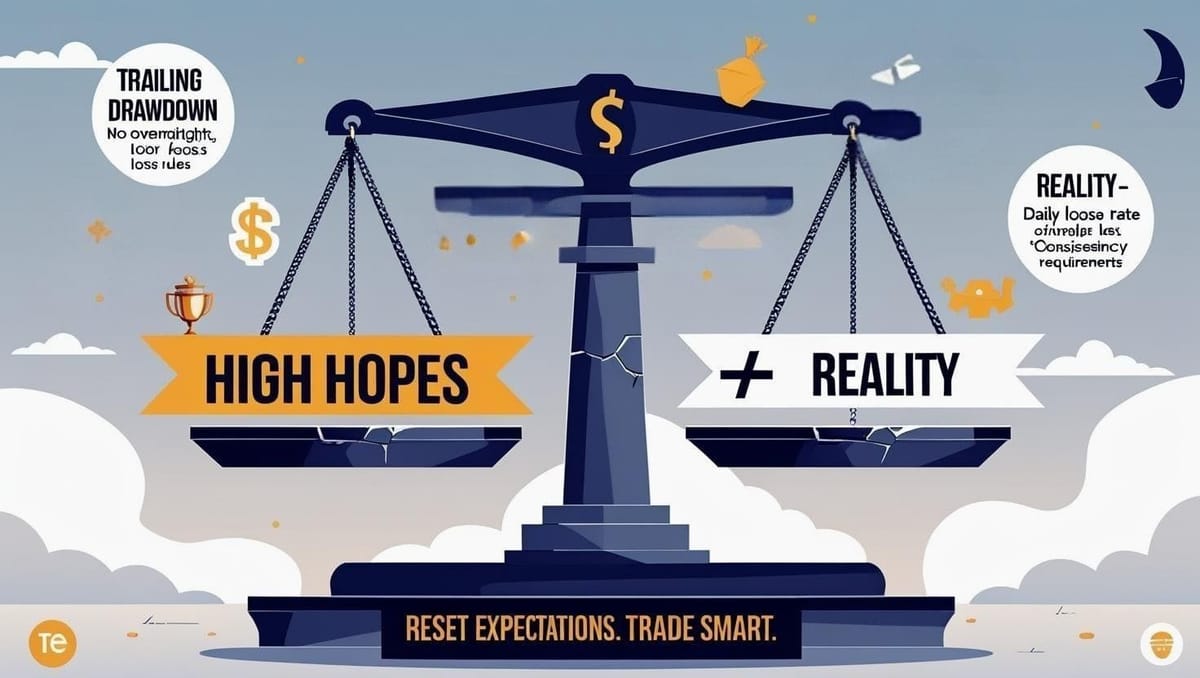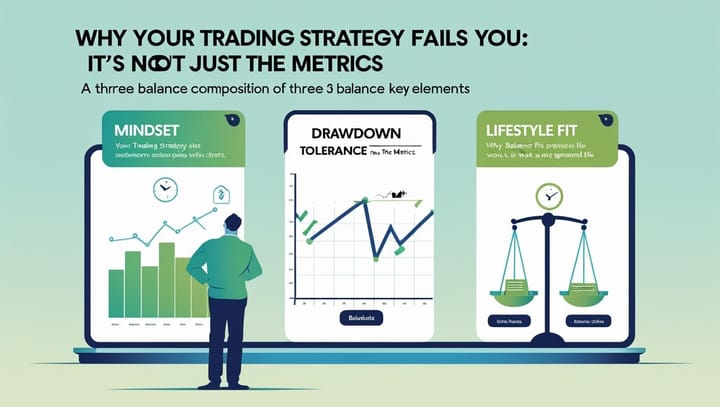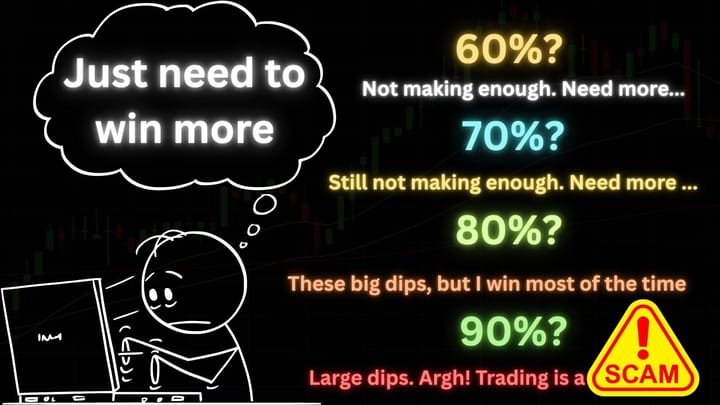The Truth About Prop Firms — Why Most Traders Fail Before They Begin
Most traders enter prop trading with big hopes and bigger misconceptions. Here’s what really happens, why most fail, and how to trade smarter.

Most traders jump into prop trading with high hopes — and even higher misconceptions. This breakdown reveals what really happens inside the prop firm game, why 95% fail, and how to play it smart.
Let us examine some questions:
- What are the problems with the prop firm accounts?
- How to reset expectations and work towards payouts?
- What and when are the positives of using prop firm accounts?
- When are these not a right fit?
This is not a post to promote or demote prop firms.
This is not an indicator or strategy tutorial either.
Problems with prop firms
The account size doesn’t mean much. Review the maximum loss limit they provide. That is your actual account size. And, look at the daily loss limit — sometimes, that could be a limiting factor for your strategy.
Your maximum loss limit is your account size.
Small and Misleading account size
For example, if you are looking at the most popular 50k futures account, you are not getting $50,000. You can only lose a maximum of $2,000 on the account. So what they are giving you is $2,000 worth of virtual money. Again, it is a $2,000 account. Additionally, these accounts are intraday only—positions cannot be held overnight.
For anyone thinking that $50,000 is due to the margins, consider the intraday-only margins offered by futures brokers like AMP. Those are low for intraday positions.
Yup, most of these prop firms are lying to you about the account size.
Huge Targets. And they mislead you again.
Now, for the 50k account, they have the target of $3,000. That looks like 6% on $50,000, and they say that as 6%. However, in reality, it is $3,000 on $2,000. That is a huge 150% target that these firms expect you to achieve. On larger accounts, it rises to 200%.
Max Trailing Loss
This depends on your account type and the prop firm. Not all have this. And further, there are two types — intraday trailing and end-of-day trailing. End-of-day trailing will trail your maximum loss by the loss limit allowed. So if you made any profit, the next day you will feel as if you started from scratch. The only benefit is that your target comes closer. And intraday trailing does it at a trade level. I could be wrong about intraday trailing — but you are forced to take base hits.
Payout problems
Be cautious when selecting a prop firm. Some do not payout. And many have complicated payout rules. Fortunately, I stuck with one of the best and have not faced payout problems yet.
Prop firm business model
They prey on traders who do not understand what they are getting into. Most traders fail, and it works in the firm’s favor. And most traders cannot achieve those huge targets and maintain sufficient consistency to earn a payout. Well, we have no stats, but most likely, 95%-99% do not get a single payout from prop firms. They struggle, rush things, get frustrated, and blow up account after account. I have heard stories where people lost six figures on prop firm evaluations. 🤯
So prop firms mostly get paid by these losing traders. And part of that goes towards payouts for profitable traders in the sim-funded stage.
Now, there are also payout gamblers/statisticians. I understand their strategies, but that is an entirely different game that I do not like to play. They know what they are doing. And probably they get banned in time.
The traders who become profitable with prop firms and take a few payouts are then moved to live accounts, and a cut is taken. Fair enough — after all, they are a business, and I do not have any qualms about that.
They are not a charity. They might say “we are here to help traders”, but they are also here to make money. Even if they are genuinely helping a trader, it also serves as a method to attract more people to their firm.
Be very cautious around prop firms that never take you Live.
The prop firms that never take you live are doing something else to sustain themselves. Often, you will hear stories of denied payouts, blocked payouts, or complete lifetime bans for weird reasons — that is, if the trader were not at fault.
Some prop firms will deliberately use conditioning techniques to manipulate you during the funded stage subtly. It’s straight out of a casino’s playbook.
A simple ‘You’re doing great’ email from a prop firm might feel encouraging — but it’s often subtle psychological manipulation. It feeds your ego, pushes you to overtrade, and before you know it, your account is gone.
So, am I complaining? NO!!!
To solve a problem, you must first understand it. That is what we did above.
The first step in solving the problem is to reset your expectations. And when you do, you might not find prop trading firms to be as attractive as they are shown to be.
Resetting Expectations
One must reset expectations to make prop firms work in your favor.
Manage risk based on real account size.
First, understand that your account sizes are relatively small compared to what they claim to be. Many eval-candidates think they have the full account size. One must manage risk based on the actual account size, rather than the inflated size.
So, if you spent $50 to purchase a 50k account with a maximum loss limit of $2,000, it is a $2,000 account. So a 2% risk per trade is 40$. A 1% risk per trade is 20$. I do not recommend a 1% risk on these small accounts, but 2% = 40$ is still a decent size if you trade with micro-futures contracts.
Practice consistency, scale later.
However, low risk also means low reward, and the destination appears to be very far away.
With small position sizes, eval feels like an exam that never finishes. And with larger sizes, you are very likely to fail.
What you must do is practice small first. The goal is not to pass the evaluation, but to learn consistency.
The 30-Day Challenge.
You might ask — how do I learn consistency? Take this challenge.
The goal is to achieve 30 days of consistent, stable trading while maintaining sufficient pressure, targeting $100-$300 per day, using micros only. Have a max daily loss limit for yourself. Trade small, one micro at a time, and create a habit. If you can sustain 30 trading days this way, your likelihood of becoming a successful trader has increased significantly. You might ask — “Why set P&L targets?”. Because someday you will set that for yourself in your real trades, and need to be prepared for it.
We are not talking about making consistent profits here; we are talking about trading consistency and discipline. One breach of the rules and you must restart.
Some pro-traders would cringe at this — “you are asking for too much with one micro”. Hey, I didn't say trading was easy, and these firms make it more complicated. But breaking a limiting belief is just as important.
You need first to practice consistency under pressure and develop survival skills. Even a single day where you break your rules should reset the day count. It will feel frustrating, desperate, and pointless. These are emotions you need to experience and deal with. It’s all a part of trading.
Unless you get consistent, don’t try to get funded. Even if you pass your eval — get another eval, don’t jump into a funded trading account just yet.
The 30-day count is a number to form a habit. It could be 21/30/66/255.
You will blow up at least once trying to get consistent under pressure. It is natural; don't beat yourself up for it. Take a break and restart.
A technique I used to practice — compare trading to an hourly minimum-wage job. You only want to make 20/30/40/50/x an hour. But you don’t want to force yourself to do it. Can you wait patiently every hour to take the trade at a proper location, with a confirmed signal, etc.? This helped me prevent overtrading. But remember, later, that was just a context you set for practice — trading is not like an hourly wage job.
Journal
Journal all those 30 days. Once you survive those 30 days, you will see a difference in your trading behavior.
To achieve the consistency benchmark, it may take several months. You might restart multiple times — hopefully improving each time.
At the end of a valid and successful journey, you will begin to see trading in a completely different light. The doubts like “whether I can trade” will never show up — never. Yes, you might question its feasibility in your life — it might not be making enough. But you will “know” you can trade. At this point, your questions would likely be about growth, making more, and finding meaning in all of it.
Scale up
Now that you have completed the 30-day journey and passed an evaluation in two months, you can look to acquire more accounts.
The skill of slow growth that you learnt is to be applied in a funded account. Grow your account patiently, and take the payouts. Use part of these payouts to get a few more funded accounts.
BUT — Do you patiently pass another eval in another 2 months or 6 months? In reality, that would be incredibly painful. So with evals — once you learnt the skill to build, unlearn the skill. You should not waste too much time on passing the evals further. Second time, try to increase the risk on your eval accounts. And because you increased the risk, you might blow up a few eval accounts in the process. Just do it strategically, and try to fund your purchases from your payouts.
The Fiat Leverage Math
Let's say it costs you $300 to get to a 50k-funded account, including a couple of evaluation blowouts and the activation fees.
For $300, you could be getting money worth $1,000 in real terms —it depends on the property firm's rules.
Let’s make it $400 for ease of calculation. For real, $400 gets you $2,000 in sim money in a funded account. That is 5x sim leverage you get. If your payout percentage is 50%, that is equivalent to $1000 and a 2.5-3x real leverage on your money. Provided that you have learnt to trade consistently.
Case in point — A theoretical example: Let’s say you risk $2000 to make $2000 on a sim-funded account with max loss as $2000. The statistical probability for a 1:1 ratio is 50% (assuming a sideways market). If you win and receive a 50% payout for the profits, you have real $1000. If you had lost, you would have only lost the actual $400 (or $300) that you spent to reach a funded account. That is a better than 2-to-1 reward-to-risk ratio with a 50% win rate. Statistically, that wins over time.
DO NOT try this theoretical example—Prop firms have rules like trailing drawdowns and consistency rules that make it very hard for such simplicity to work.
Prop firms are not a cheaper lottery ticket.
You might think that the cost is relatively low, and hence you could gamble more for the same amount. NO. The rules are made to prevent a jackpot win. For example: The Consistency Rule. You may win a jackpot once, but you cannot win a jackpot 4–5 times in a row — and that is what you would need if you gamble with full account size. In such cases, you will have better luck in the real markets.
Positive side of these prop firms
However, let’s look at the positive side. And I believe these outweigh the negatives, especially for new traders.
A 50k account (read: 2k) costs only $50 or $100 or $200 monthly , based on which firm you are selecting. The first account you get is an evaluation account.
Better than paper trading — Skin in the game
If you have never traded before, consider experimenting with a paper trading account to determine the optimal trading times and strategy you want to use. Once you have that, don’t waste time on paper trading.
You have skin in the game. The prop firm eval accounts are just simulated environments. But you paid real money to get the account. And the potential payout from a funded account is real, too. This makes it better than a paper-trading account. Here, you feel the pressures that you would not experience on a paper-trading account.
Your losses are limited.
All you are losing is your $50/$100/$200 for an account.
Trading is hard, and it is challenging to achieve the 150% and 200% targets set by the prop firms.
If you “think” you can win and have never done it before, you are already in the bottom 90-95%. The winners “know” they win — their accounts and statements show it. A couple of lucky hits don’t count. It’s called beginner’s luck.
Think about it — Is it okay to lose $100 or lose $2000 on a real account?
I am not saying that you cannot make a profit trading. But making consistent and meaningful profit is a different ballgame. It’s not a sprint, but a marathon. (Unless sprinting is strategic)
Lack of capital.
If you have minimal risk capital, you can build up your capital through trading with prop firms. Many firms allow for multiple accounts (5–10 accounts) and copy-trading across your accounts.
So, if you have five funded accounts with a $2,000 maximum loss, then you have a total capital of $10,000 allocated, which approximately costs you $1,000, including all costs. Many firms also allow copy trading across your accounts.
Don’t get greedy. First, try to pass the eval and get funded. And then stay funded and take a payout before attempting multiple accounts. Fund more accounts with part of the payouts and your patience.
Trading teaches you about yourself.
Doesn’t matter if you become a profitable trader or not. If you make an effort to get good at trading, you will learn a lot about yourself. Trading is a psychological mirror. Some of the strategic thinking and psychological lessons learnt here will help you in other aspects of your life. Somewhat similar to how coding teaches you critical thinking, except that trading can be addictive and can ruin you financially and emotionally.
And the cost you end up paying via prop firms is much lower than what you would do with your own money.
Trading can also get addictive when you treat the markets like a casino.
You might* become a better and strategic trader.
I knew how to trade, and I had certain limiting beliefs about what constituted good trading performance and what was required as a drawdown. However, the targets of prop firms with low loss limits prompted me to reconsider my approach. It forced me to evaluate risk and leverage in a different way. Ultimately, this led to the development of better-performing strategies.
Final thoughts…
Why did I choose prop firms? The reasons were pretty simple — complex regulations, and I needed access to trade Nasdaq futures (NQ) for a new model that I had built. It looked easier and cheaper to dabble with a prop firm account. And I am glad I did, it changed the trading game for me forever, breaking my limiting beliefs, and making me a better trader.
I do not recommend trading prop firms to everyone. Your strategy might need a higher drawdown. Maybe you have a lot of risk-capital, and are happy with small returns — why would you risk large absolute amounts? Perhaps you need to swing trade only, which is often more profitable than day trading, but your firm does not allow it.




Comments ()